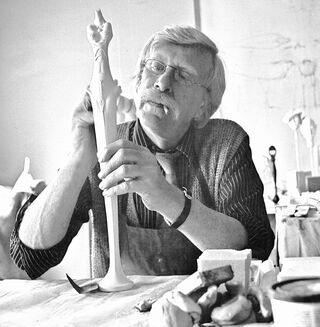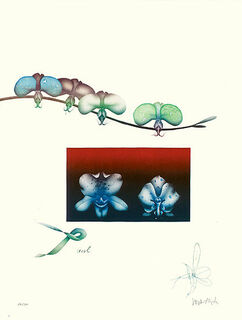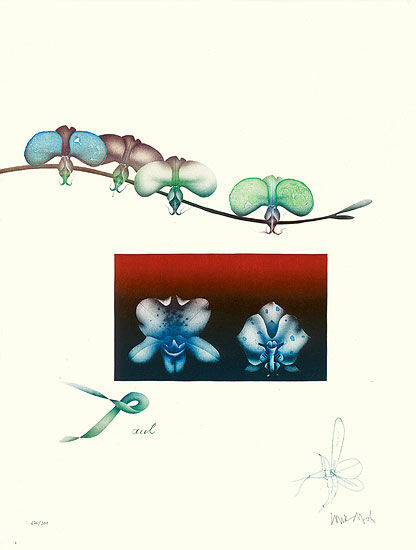Picture "Orchid II", catalogue raisonné no. 725, unframed


Picture "Orchid II", catalogue raisonné no. 725, unframed
Quick info
limited, 301 copies | numbered | signed | colour lithograph on handmade paper | unframed | size 50 x 65 cm
Detailed description
Picture "Orchid II", catalogue raisonné no. 725, unframed
Paul Wunderlich was inspired to create his print series called "Orchids" due to his fascination for orchids, their aesthetics and their symbolism. He exploits all the lithographic possibilities to the maximum: The surface structure is created through the use of the refined wash technique, and the surfaces are further modelled through iridescent printing and the use of the airbrush technique. His flower motifs follow the tradition of still life as an allegorical representation. The result is a world of precisely formulated ambiguity, myth and elegance: elongated calyxes and petals unfold their own world in the service of beauty and aesthetics. There are sketches next to completely finished sections of the picture. While stimulating the viewer's imagination, they tempt to distract, by pointing to the completed parts of the picture, to concentrate.
Original colour lithograph on Rives handmade paper. Limited edition of 301 copies, numbered and signed by hand. Unframed. Sheet size 50 x 65 cm.

About Paul Wunderlich
1927-2010
Like no other artist of our time, Paul Wunderlich was one of the most influential style-forming artists of the modern age. Only in 1960, the Hamburg prosecutor seized his works for "indecent". Three years later, the relativley young Paul Wunderlich was hired as a professor at the University of Fine Arts. Numerous awards such as the Edwin Scharff Prize honours at the biennial arts exhibition in Ireland, Taiwan and Bulgaria made Wunderlich internationally famous. He was the only German artist to be admitted to the Paris "Académie des Beaux-Arts". Paul Wunderlich lived and worked both in Hamburg and France until his death in June 2010.
Born in 1927 in Eberswalde near Berlin, the painter and sculptor learned to draw at the Palace School of Art in the Orangery of Eutin Castle. Immediately after World War II, he visited the Hamburg Academy of Fine Arts to study graphic arts. After completing his studies, he remained there working as a drawing teacher and in 1963 became a professor.
In the early 1950s, he met Emil Nolde and Oskar Kokoschka. Under their guidance he printed reproductions of their works. He developed a very idiosyncratic style in which manneristic and surrealistic, as well as elements of Art Nouveau and Art Deco, meet. He initially drew his themes inspired by German history, for example the cycle of lithographs "20 July 1944". Later, erotic and sexual motifs became more significant which he treated with delicacy and also a hint of morbidity. In 1960, one such cycle of lithographs was seized by the Hamburg prosecutor for indecent depictions.
In the 1960s he began to work based on photographs by Karin Székessy. After he resigned from his professorship in 1968, he made several study trips to New York and Switzerland. From then on, he also worked on sculpturally aestheticised everyday objects that were parallel with the subtly crafted imagery of his lithographs.
"His works are recognised, appreciated and also bought by a broad public all over the world," writes Paul Wunderlich's biographer Jens Christian Jensen. "Art connoisseurs agree: Paul Wunderlich is the leading master of fantastic realism and one of the very few style-forming artists of our time."
"Out of all the truisms that are spread about his life's work, only one fact is for sure: the realisation that Paul Wunderlich became the unsurpassed master of lithography after Picasso." (Prof. Heinz Spielmann)
"If one searches for the greatest master in the art of lithography in all its possibilities, there is no doubt that Paul Wunderlich deserves all credits." (Carl Vogel)
The field of graphic arts, that includes artistic representations, which are reproduced by various printing techniques.
Printmaking techniques include woodcuts, copperplate engraving, etching, lithography, serigraphy.


